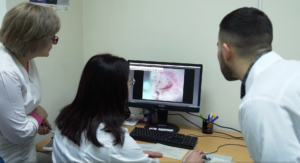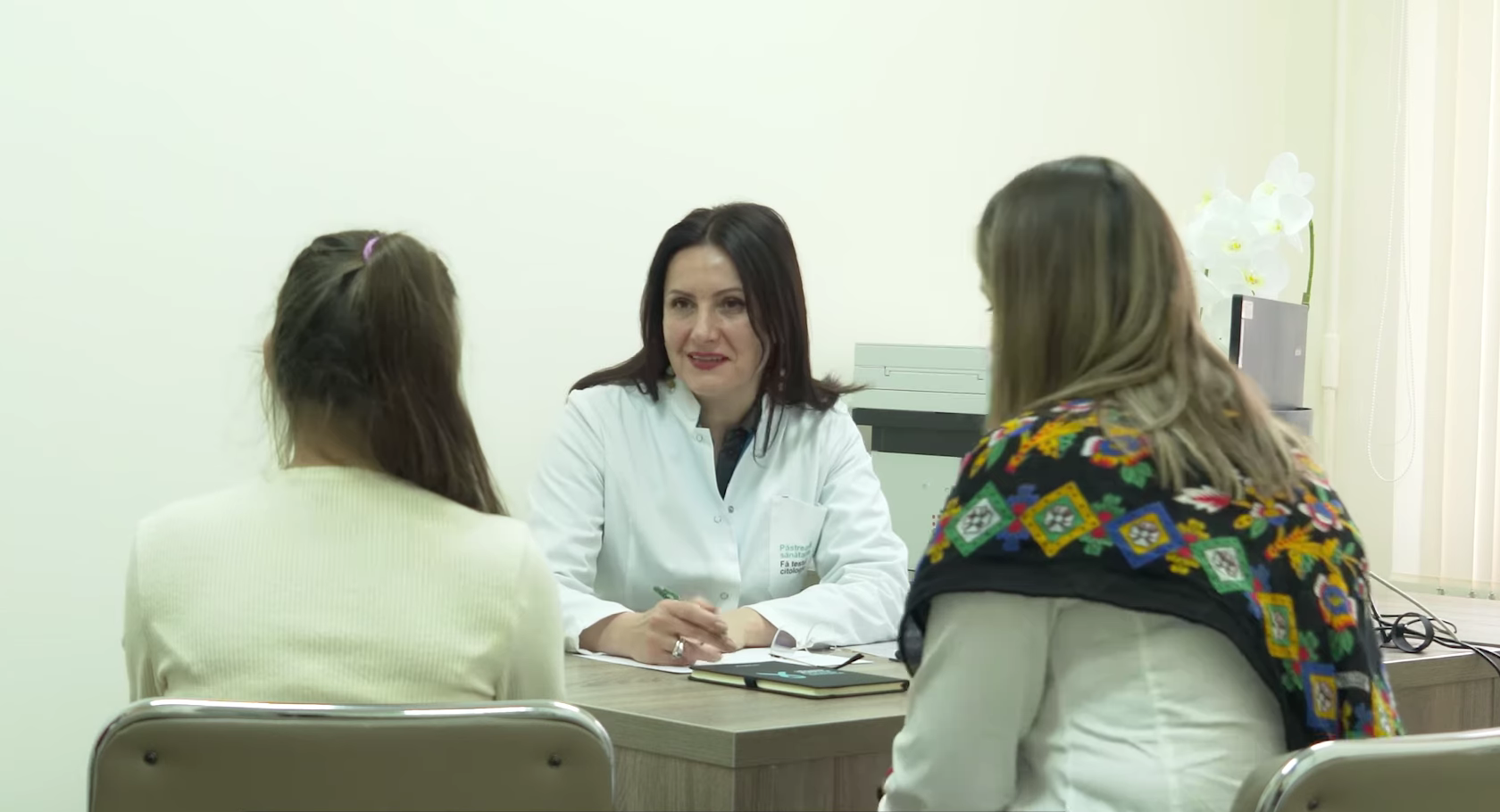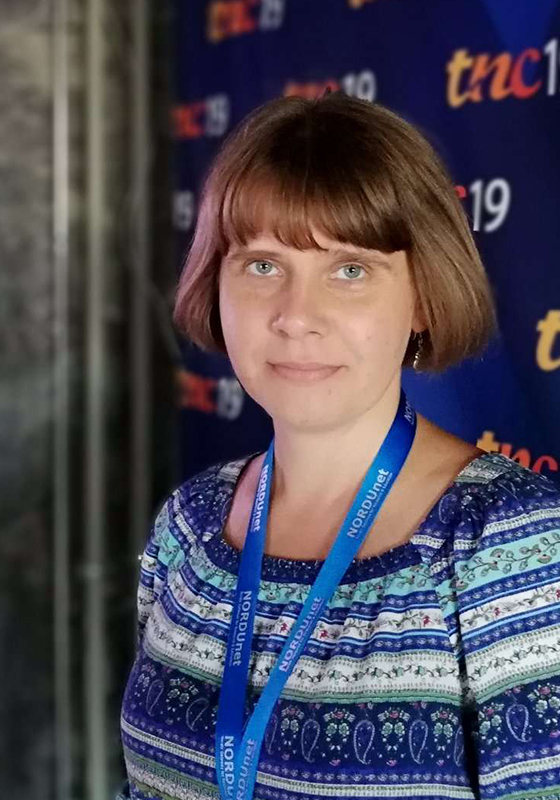Interview with Dr. Diana Valuta, Head of the Cervical Screening Coordination Unit, Obstetrician-Gynaecologist, Oncologist, Research Institute for Mother and Child Health Care.
Dr. Diana Valuta was one of the invited speakers at the International Conference ‘RENAM E-Infrastructure – Supporting Excellence in National Research and Education’, organised under the auspices of the project ‘EU4Digital: Connecting Research and Education Communities (EaPConnect)’. The event took place on October 8, 2024 at the Moldova State University bringing together participants from 14 countries.
Dr Valuta, can cervical cancer be eliminated?
Cancer remains a major problem and one of the most important contemporary public health issues. Every year, at least 10 million people around the world die from cancer, and an additional 20 million people are diagnosed with a new disease. In practical figures, this means that one in five people will develop cancer in their lifetime, while one in 11 men and one in eight women will die from it. Currently, 50 million people are living with cancer, and individuals have lived for more than five years are considered survivors.
In the structure of oncological diseases in women, breast cancer remains at the top, followed by colorectal cancer, lung cancer, cervical cancer, and thyroid cancer. But only cervical cancer can be completely eradicated from the lives of 21st-century women. And that is not a populist statement, but a truth based on research and knowledge, because only cervical cancer has a long pre-morbid (pre-cancerous) period, usually seven, 10 or 12 years with a possibility of being diagnosed and treated early. This window makes preventive action possible. It is a golden window, and we, in modern medicine, must know and utilise it correctly to eliminate this disease. Only two interventions are needed: vaccination against Human Papillomavirus and cervical screening of women aged 25+ years.
What are the specific challenges facing the Republic of Moldova in this area?
In modern medicine, many solutions have been developed to ensure high-quality medical services, beginning with data recording and analysis. Performance in healthcare relies heavily on accurate data, and without it, the medical process risks leading to more challenges than benefits. Information technologies in healthcare focus on improving data access and analysis, boosting performance, facilitating research and learning, and addressing human resource challenges. Unfortunately, the human resource crisis in the Republic of Moldova remains unresolved. This issue extends beyond the mere shortage of healthcare professionals. It also encompasses the quality of their work, their efficiency, and the alignment of their knowledge and skills with contemporary requirements.
The country is grappling with a shortage of medical staff, many of whom are inadequately qualified. Additionally, there is limited opportunity to offer proper training within the Research Institute for Mother and Child Health Care. Even when effective training is provided, staff often return to their clinical practices feeling uncertain about their skills. This creates a situation where further support is needed for medical professionals to gain confidence in their abilities when performing procedures.
What were the main achievements following the approval of the organised Cervical Screening implementation plan in the Republic of Moldova in 2014?
 The two major achievements of our programme are the establishment of the Cervical Screening Registry and the colposcopy through telemedicine.
The two major achievements of our programme are the establishment of the Cervical Screening Registry and the colposcopy through telemedicine.
One of the most significant tools we’ve developed and successfully implemented since 2021 is the Cervical Screening Registry. This registry is a module within the Automated Information System ‘Primary Health Care’ platform. It contains all the essential components to support a comprehensive system for inviting women to undergo screening tests. It also enables the creation of lists of eligible women by family doctors, ensuring that national data is accurately recorded and tracked. This registry plays a crucial role in improving outreach and enhancing the efficiency of the cervical screening programme across the country.
Personal data is imported into the Cervical Screening Registry from the State Register of Population, serving as the primary source of information. Women are identified using their identity number, which allows us to retrieve all necessary data. Access to the screening registry by healthcare providers is secured through a secure authentication process, ensuring privacy and confidentiality. Participation in the screening programme requires the informed consent of women, which is mandatory. The registry itself was developed using eight standardised forms, ensuring consistency and accuracy in data collection. The development of this registry has been a significant step forward, as it has helped clarify the information and patient flows within the cervical screening programme. It has allowed us to streamline the process, bringing us closer to a centralised and well-organised framework across our entire system, ensuring better coordination and efficiency in delivering screening services.
This allowed us to prepare for the next long-awaited phase: the digitalisation of processes and services within the cervical screening programme. We started planning it in 2016. Today, we have a successful example of digitalisation of a key area of cervical screening – the colposcopy service. Through this digital transformation, we are now able to offer all women diagnosed with certain atypia the opportunity for accurate diagnosis and successful treatment.
The National Colposcopy Network in the Republic of Moldova was launched in November 2023. What does its activity look like now, in 2025, and what has been its impact?
 We have established 12 colposcopy offices across the country at the hospitals of the districts of Soroca, Comrat, Cahul, Causeni, Ungheni, Orhei, Drochia, and Ceadir-Lunga, as well as Balti Clinical Hospital and the Chisinau hospitals (the Research Institute for Mother and Child Health Care, the Institute of Oncology and the Municipal Clinical Hospital ‘Gheorghe Paladi’), connected to the National Colposcopy Referral Centre in Chisinau. The logic and idea of creating the infrastructure of the National Colposcopy Network was to bring colposcopy services as close as possible to our beneficiaries whilst meeting all quality assurance requirements.
We have established 12 colposcopy offices across the country at the hospitals of the districts of Soroca, Comrat, Cahul, Causeni, Ungheni, Orhei, Drochia, and Ceadir-Lunga, as well as Balti Clinical Hospital and the Chisinau hospitals (the Research Institute for Mother and Child Health Care, the Institute of Oncology and the Municipal Clinical Hospital ‘Gheorghe Paladi’), connected to the National Colposcopy Referral Centre in Chisinau. The logic and idea of creating the infrastructure of the National Colposcopy Network was to bring colposcopy services as close as possible to our beneficiaries whilst meeting all quality assurance requirements.
All colposcopy units in Moldova are now equipped with standardised colposcopic video and electrosurgical equipment, all connected through a digital application that links them to one another and to the referral centre. As a result, women no longer need to travel to the capital for services. Specialists in regional areas are now able to perform colposcopy with biopsy under the supervision of telemedicine, ensuring high-quality care closer to home. This initiative has significantly improved referral rates for colposcopy, particularly for women in rural areas of the country.
Over the past three years, we have achieved significant progress in several key areas: we have doubled the coverage of primary cytology tests, doubled attendance at colposcopy services to 72% (largely due to telemedicine), and tripled the coverage for the diagnosis and treatment of precancerous lesions, now reaching 78%. We continue to take a dual approach in tackling cervical cancer, focusing on both vaccination and screening. Vaccination coverage has reached 57%, with both girls and boys being vaccinated as part of the national immunisation protocol.
How would you rate the quality of technological support provided by RENAM, the videoconferencing system based on the BigBlueButton platform?
We reached out to RENAM for support in providing videoconferencing capabilities across our network with guidance from the Research Institute for Mother and Child Health Care for every colposcopy office in the Republic of Moldova. Now we have remote access to medical cases allowing us to support doctors 100-200 km away to perform high quality medical procedures and, with our assistance from Chisinau, to perform even minimally invasive surgery when necessary, saving both time and money for patients. What makes us proud is that women can have a biopsy in their own regions: now we can observe how the biopsy is done. Additionally, this initiative has been crucial in encouraging a proactive approach among specialists in remote regions, empowering them to take a more active role in patient care.
The videoconferencing system based on the BigBlueButton platform, which we have been using almost daily for more than a year, facilitates these guided telemedical sessions. From our experience, that it is very secure, very reliable, and has a large data storage capacity. We are pleased with the quality, resolution, and speed of the transmitted video sequences, which allows us to monitor well the examination process and provide support with recommendations when necessary.
Moreover, one of the key achievements has been the standardisation of processes, the creation of an extensive archive of photo and video materials, and the modernisation of both the curative and educational processes. This progress motivates us to continue growing and advancing in our efforts!
What are the desired goals for the future?
The next step we aim to take is to continue the digitalisation of other services within cervical screening, such as laboratory services, cytology and histopathology. This opens a path to the video and photo archive that will allow us to develop an artificial intelligence tool to improve the analysis of histopathology results. Also, we are considering the development of quality assurance mechanisms in education and research to address the challenges of human resource resistance, by creating a hub for training medical personnel in digital processes.
While advanced technologies in medical processes often seem as though they’ve been introduced with a ‘magic wand’, I firmly believe that behind this ‘magic’ is a great deal of hard work, numerous processes, and a significant amount of responsibility – all of which are crucial for the success of our efforts.




